- ¿Qué es un parque nacional?
-
- Mar de las Calmas (propuesta)
- Aigüestortes i Estany de Sant Maurici
- Cabrera Archipelago
- Cabañeros
- Caldera de Taburiente
- Doñana
- Garajonay
- Atlantic Islands of Galicia
- Monfragüe
- Ordesa y Monte Perdido
- Picos de Europa
- Sierra de Guadarrama
- Sierra de las Nieves
- Sierra Nevada
- Tablas de Daimiel
- Teide
- Timanfaya
- La Red de un vistazo
- ¿Cómo funciona La Red?
- Cartography
- Central Booking
Transectos: Balcón de Pilatos
Transectos: Balcón de Pilatos
 Resumen de las observaciones realizadas en cada metro de profundidad en Balcón de Pilatos (Chafarinas). Autor: Luis Sánchez Tocino. Universidad de Granada
Resumen de las observaciones realizadas en cada metro de profundidad en Balcón de Pilatos (Chafarinas). Autor: Luis Sánchez Tocino. Universidad de Granada
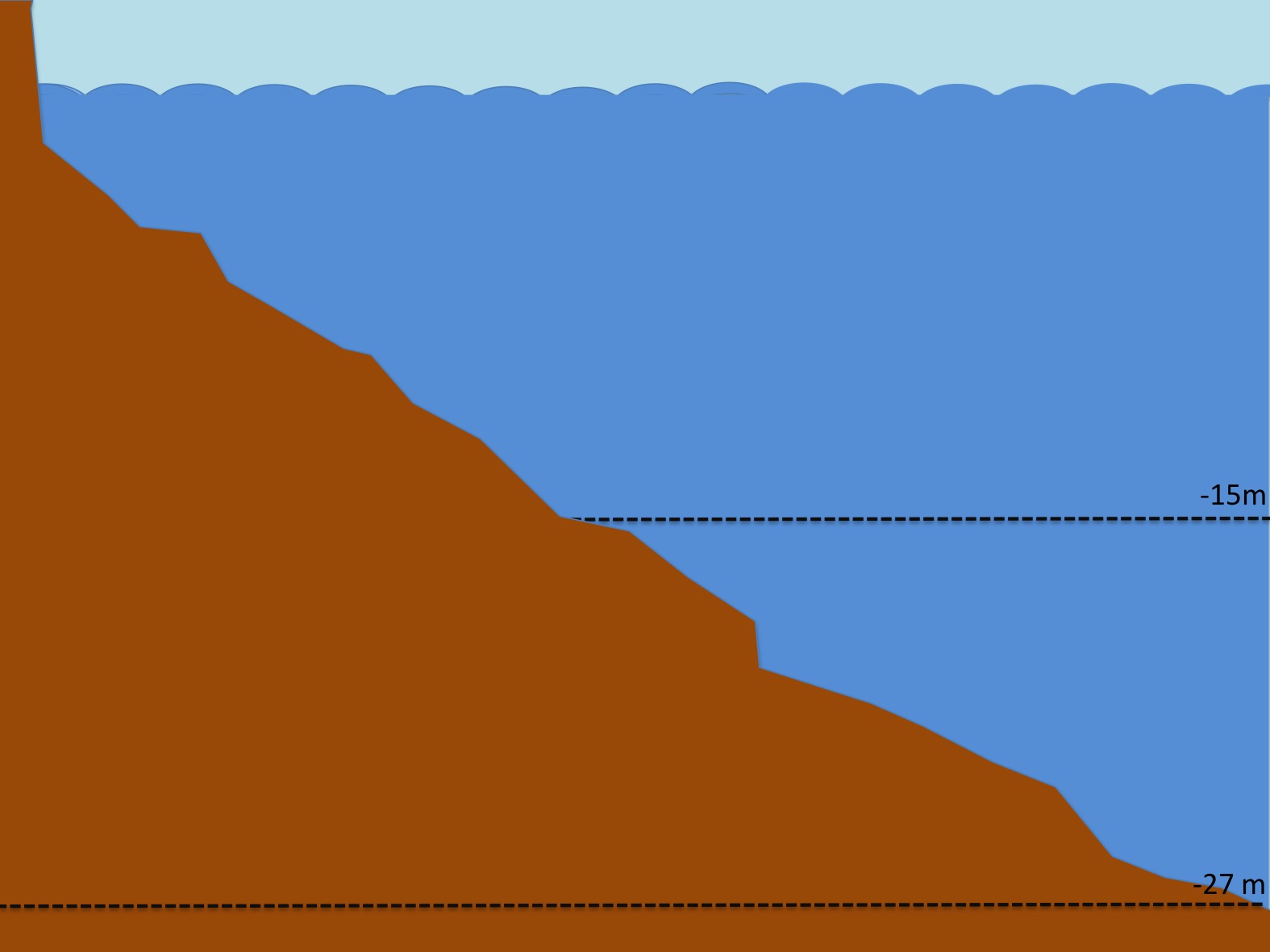 Representación del relieve del terreno en Balcón de Pilatos
Representación del relieve del terreno en Balcón de Pilatos
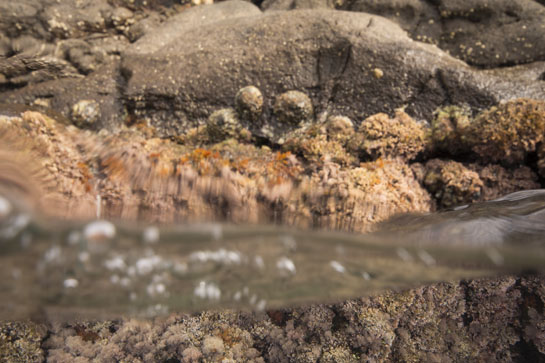 0m. Justo por encima del cinturón de algas del mediolitoral, se pueden observar varios ejemplares de lapas pertenecientes a la especie Patella rustica.
0m. Justo por encima del cinturón de algas del mediolitoral, se pueden observar varios ejemplares de lapas pertenecientes a la especie Patella rustica.
 0m. Las algas rojas predominan en el mediolitoral inferior.
0m. Las algas rojas predominan en el mediolitoral inferior.
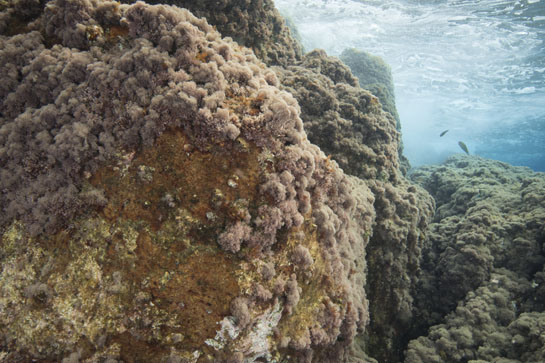 –1m. Entre las algas rojas se pueden observar varios ejemplares del cirrípedo Balanus perforatus.
–1m. Entre las algas rojas se pueden observar varios ejemplares del cirrípedo Balanus perforatus.
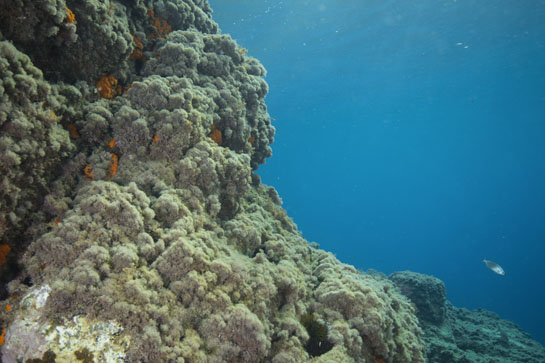 –2m. Las colonias del coral naranja (Astroides calycularis) aprovechan los ambientes umbríos de las grietas y extraplomos para asentarse.
–2m. Las colonias del coral naranja (Astroides calycularis) aprovechan los ambientes umbríos de las grietas y extraplomos para asentarse.
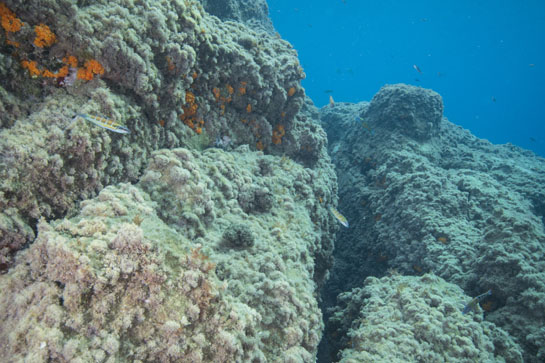 –3m. Dos fredis (Thalassoma pavo) nadan sobre un fondo de algas rojas y coral naranja.
–3m. Dos fredis (Thalassoma pavo) nadan sobre un fondo de algas rojas y coral naranja.
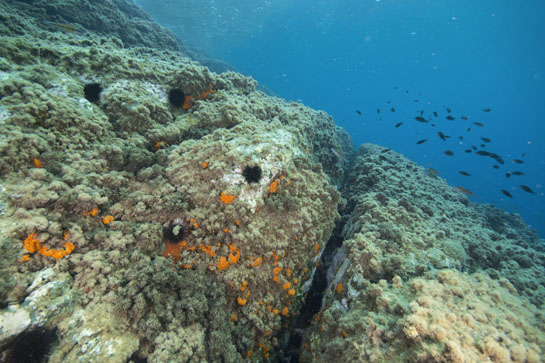 –4m. El ramoneo de los erizos deja pequeñas zonas blanquecinas entre el bosque de algas.
–4m. El ramoneo de los erizos deja pequeñas zonas blanquecinas entre el bosque de algas.
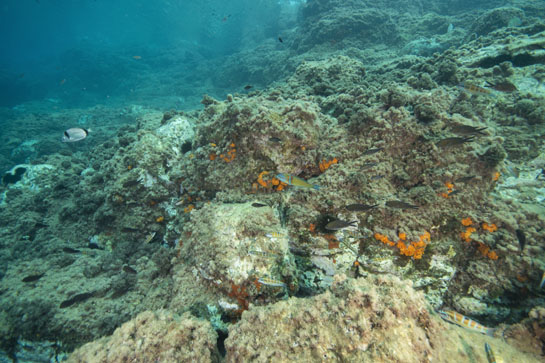 –5m. Un macho terminal de fredi (Thalassoma pavo) nada sobre un grupo de hembras.
–5m. Un macho terminal de fredi (Thalassoma pavo) nada sobre un grupo de hembras.
 –6m. En el centro de la imagen, justo por encima de un erizo común (Paracentrotus lividus), se puede observar un ejemplar de la esponja Ircinia fasciculata.
–6m. En el centro de la imagen, justo por encima de un erizo común (Paracentrotus lividus), se puede observar un ejemplar de la esponja Ircinia fasciculata.
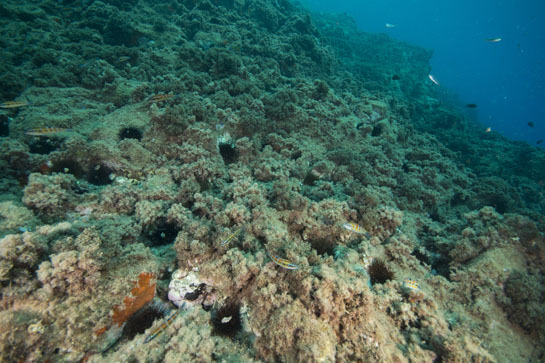 –7m. El gran número de fredis se debe a que se alimentan de los pequeños invertebrados que levantan los submarinistas con las aletas.
–7m. El gran número de fredis se debe a que se alimentan de los pequeños invertebrados que levantan los submarinistas con las aletas.
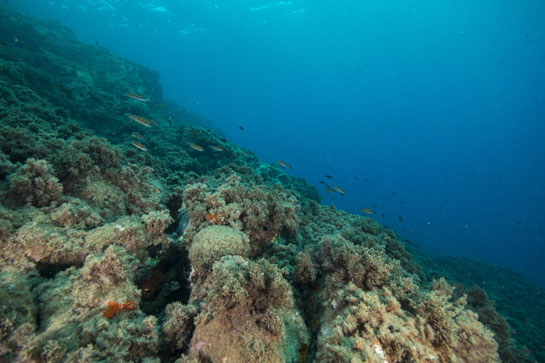 –8m. A esta profundidad predomina el alga parda (Halopteris scoparia). En la parte central, un ejemplar del alga verde (Codium bursa), con forma esférica.
–8m. A esta profundidad predomina el alga parda (Halopteris scoparia). En la parte central, un ejemplar del alga verde (Codium bursa), con forma esférica.
 –9m. Las esponjas rojas (Cambre cambre) recubren los pocos espacios dejados por las algas pardas.
–9m. Las esponjas rojas (Cambre cambre) recubren los pocos espacios dejados por las algas pardas.
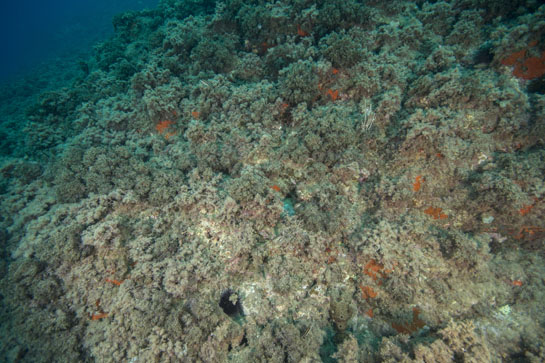 –10m. Las primeras gorgonias de la especie Eunicella singularis aparecen a esta profundidad.
–10m. Las primeras gorgonias de la especie Eunicella singularis aparecen a esta profundidad.
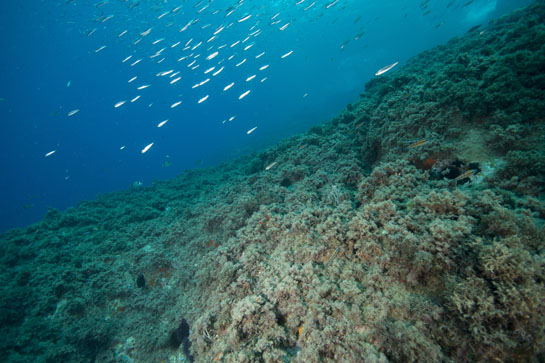 –11m. Un grupo de bogas (Boops boops) nada sobre un fondo cubierto principalmente por el alga parda Halopteris scoparia.
–11m. Un grupo de bogas (Boops boops) nada sobre un fondo cubierto principalmente por el alga parda Halopteris scoparia.
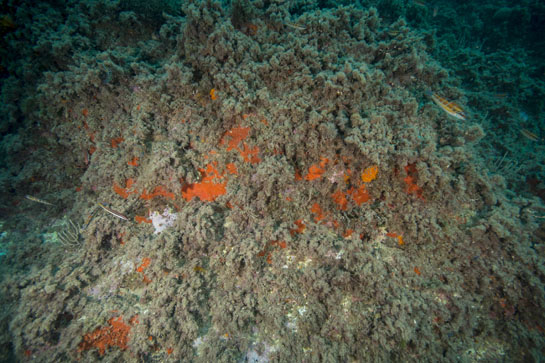 –12m. Esponjas rojas y coral naranja crecen en esta pequeña pared vertical, rodeados de algas pardas.
–12m. Esponjas rojas y coral naranja crecen en esta pequeña pared vertical, rodeados de algas pardas.
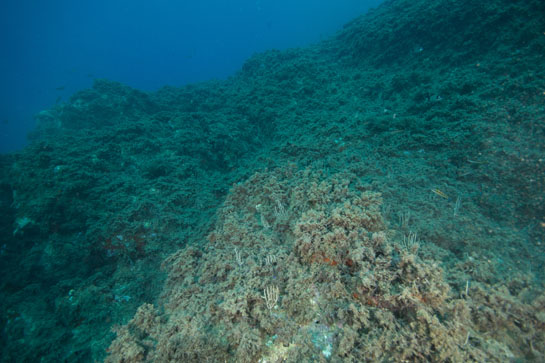 –13m. Prácticamente ha desaparecido lo que hasta el verano pasado era una próspera comunidad de la gorgonia blanca (Eunicella singularis).
–13m. Prácticamente ha desaparecido lo que hasta el verano pasado era una próspera comunidad de la gorgonia blanca (Eunicella singularis).
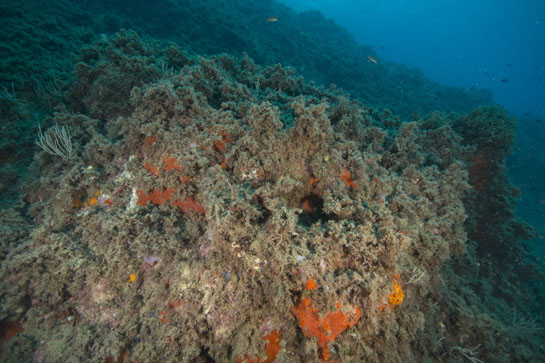 –14m. Las gorgonias muertas están totalmente epifitadas por invertebrados y algas.
–14m. Las gorgonias muertas están totalmente epifitadas por invertebrados y algas.
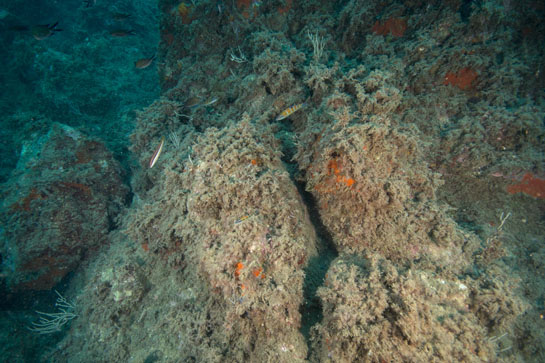 –15m. Fredis (Thalassoma pavo), julias (Coris julis) y de color negro las castañuelas (Chromis chromis).
–15m. Fredis (Thalassoma pavo), julias (Coris julis) y de color negro las castañuelas (Chromis chromis).
 –16m. A esta profundidad casi todos los ejemplares de Eunicella singularis están muertos y fuertemente epifitados.
–16m. A esta profundidad casi todos los ejemplares de Eunicella singularis están muertos y fuertemente epifitados.
 –17m. El pequeño extraplomo sirve de asentamiento a diferentes especies de esponjas rojas, coral naranja y el alga verde de ambientes umbríos Flabellia petiolata.
–17m. El pequeño extraplomo sirve de asentamiento a diferentes especies de esponjas rojas, coral naranja y el alga verde de ambientes umbríos Flabellia petiolata.
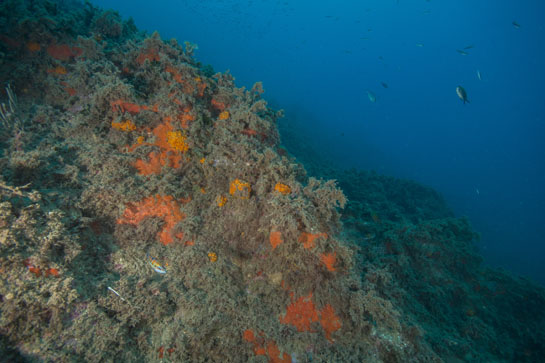 –18m. El coral anaranjado (Astroides calycularis) y las esponjas rojas dan colorido al fondo, a esta profundidad.
–18m. El coral anaranjado (Astroides calycularis) y las esponjas rojas dan colorido al fondo, a esta profundidad.
 –19m. La estrella Echinaster sepositus destaca por su llamativo color rojo.
–19m. La estrella Echinaster sepositus destaca por su llamativo color rojo.
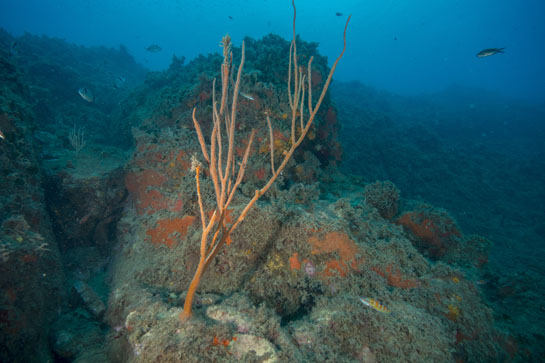 –20m. Un ejemplar de la gorgonia Ellisella paraplexauroides, en bastante buen estado.
–20m. Un ejemplar de la gorgonia Ellisella paraplexauroides, en bastante buen estado.
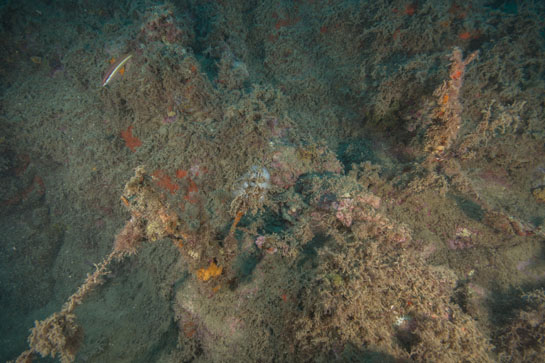 –21m. En este caso sólo queda la parte inferior, fuertemente epifitada, de dos colonias de Ellisella paraplexauroides, posiblemente arrancadas por hilos de pesca, de los que se pueden observar varios fragmentos.
–21m. En este caso sólo queda la parte inferior, fuertemente epifitada, de dos colonias de Ellisella paraplexauroides, posiblemente arrancadas por hilos de pesca, de los que se pueden observar varios fragmentos.
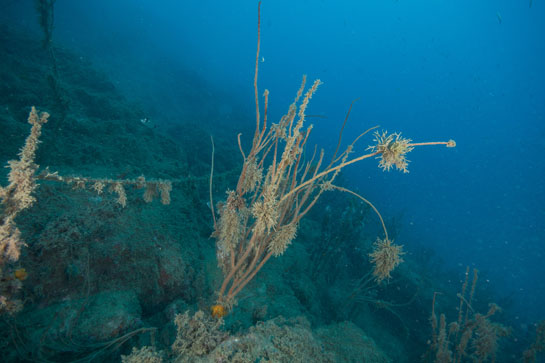 –22m. La gran cantidad de restos de hilos de nylon (posiblemente de palangres), indican la fuerte presión pesquera a la que está sometida esta zona.
–22m. La gran cantidad de restos de hilos de nylon (posiblemente de palangres), indican la fuerte presión pesquera a la que está sometida esta zona.
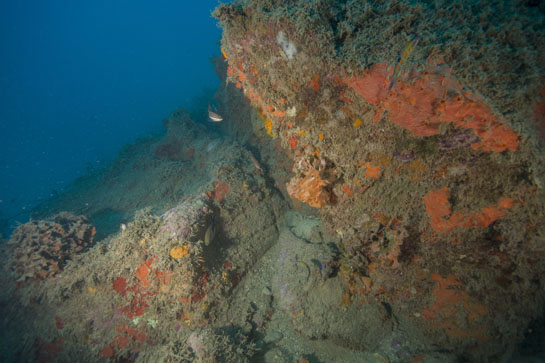 –23m. En la parte izquierda y derecha, dos colonias parcialmente epifitadas del briozoo de color naranja (Pentapora fascialis) y en la parte central una de "encaje de venus" (Reteporellagrimaldi).
–23m. En la parte izquierda y derecha, dos colonias parcialmente epifitadas del briozoo de color naranja (Pentapora fascialis) y en la parte central una de "encaje de venus" (Reteporellagrimaldi).
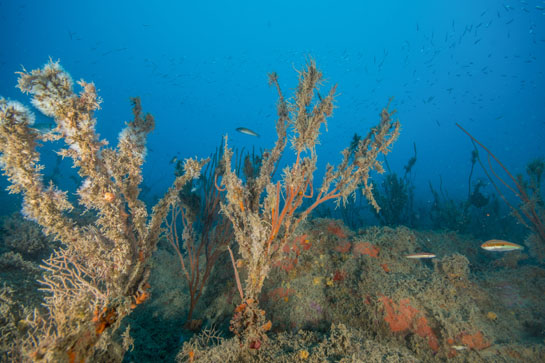 –24m. Un grupo de Ellisella paraplexauroides fuertemente epifitadas.
–24m. Un grupo de Ellisella paraplexauroides fuertemente epifitadas.
 –25 m. Esponjas rojas y las dos variedades de Paramuricea clavata (amarilla y morada), se asientan en esta pared vertical, debajo de un “bosque” de Ellisella paraplexauroides, muy epifitadas.
–25 m. Esponjas rojas y las dos variedades de Paramuricea clavata (amarilla y morada), se asientan en esta pared vertical, debajo de un “bosque” de Ellisella paraplexauroides, muy epifitadas.
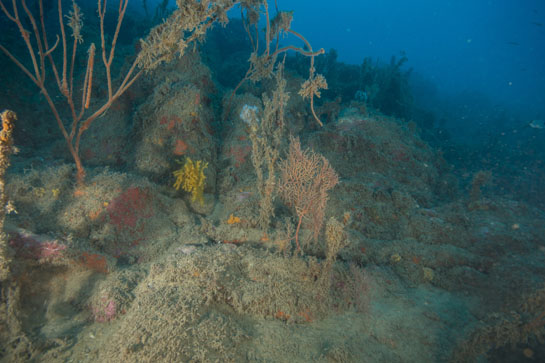 –26m. En esta imagen, aparte de Ellisella paraplexauroides, se pueden ver otras dos especies de gorgonias, de amarillo Paramuricea clavata y de color ladrillo Leptogrogia sarmentosa.
–26m. En esta imagen, aparte de Ellisella paraplexauroides, se pueden ver otras dos especies de gorgonias, de amarillo Paramuricea clavata y de color ladrillo Leptogrogia sarmentosa.
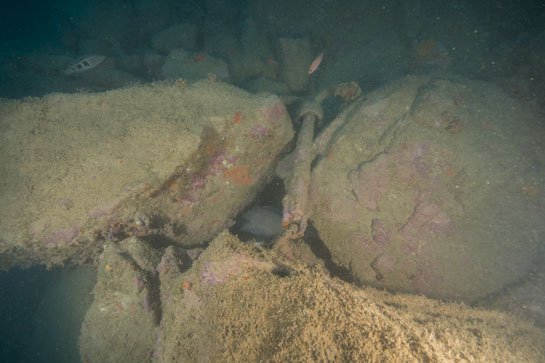 –27m. Un Serranus atricauda y un tres colas (Anthias anthias) nadan cerca de un anclote. Debajo de éste se puede ver parte del cuerpo de un congrio (Conger conger) de gran tamaño.
–27m. Un Serranus atricauda y un tres colas (Anthias anthias) nadan cerca de un anclote. Debajo de éste se puede ver parte del cuerpo de un congrio (Conger conger) de gran tamaño.
This page provides information on cookies we use: We use our own and third-party cookies to keep your session active, personalise your experience, and collect anonymous statistics about how you use this website. You can choose to accept all cookies or select which types you'd like to allow. To learn more about the cookies we use, read our Cookies Policy.
We use two types of cookies on this site. First, there are Functional Cookies, which are essential for the website to work properly. They store session data to make your experience smoother and more convenient. On the other hand, Analytical Cookies collect information about how you use the portal, without personal data, helping us provide a better and more tailored service.
Introduction to the Use of Cookies on the MITECO.gob.es Website
Cookies are small files that are stored on your device when you visit a webpage. They are essential tools that help provide many of the services available on the information society. Among other things, cookies allow a webpage to store and retrieve information about a user's browsing habits or their device. Based on this information, they can be used to recognise the user and enhance the service provided.
Types of Cookies
Depending on the entity that manages the domain from which the cookies are sent and processes the data, there are two types of cookies: first-party cookies and third-party cookies.
There is also a second classification based on how long the cookies remain stored in the user's browser: session cookies and persistent cookies.
Finally, cookies can also be classified into five types based on the purpose for which the data is processed: technical cookies, personalisation cookies, analytics cookies, advertising cookies, and behavioural advertising cookies.
For more information on this, you can refer to the Guide on the use of cookies from the Spanish Data Protection Agency.
Cookies used on the website
The web portal of the Ministry for Ecological Transition and the Demographic Challenge uses Adobe Analytics, an analytics tool that helps website and application owners understand how visitors interact with their content. Adobe Analytics uses a small number of cookies to collect data and generate usage statistics for websites. This information is sent anonymously and is not shared with third parties under any circumstances. You can choose to accept or reject these cookies, as they do not affect the portal’s functionality. However, they help provide valuable information that allows us to offer a better and more tailored service. For more information about Adobe Analytics cookies and privacy, please refer to the following links:
Additionally, pages featuring content from social network X will only set cookies if the user is logged into the X site. For more details on these cookies, please refer to the following link: Privacy on Social Network X
Finally, a technical cookie named MITECO-compliance is stored, which is a first-party, technical, and session-based cookie. It manages user consent for the use of cookies on the website, remembering which users have accepted them and which have not, ensuring that those who have accepted are not shown cookie consent messages at the top of the page. This cookie is essential for the proper functioning of the portal.
Cookies Policy Acceptance / Rejection
The Ministry for Ecological Transition and the Demographic Challenge gives you the option to accept or reject cookies that are not essential for the portal's operation. Upon accessing the portal, a message will be displayed in the centre of the page with information about the cookie policy and the following options:
· Firefox
· Chrome
· Safari